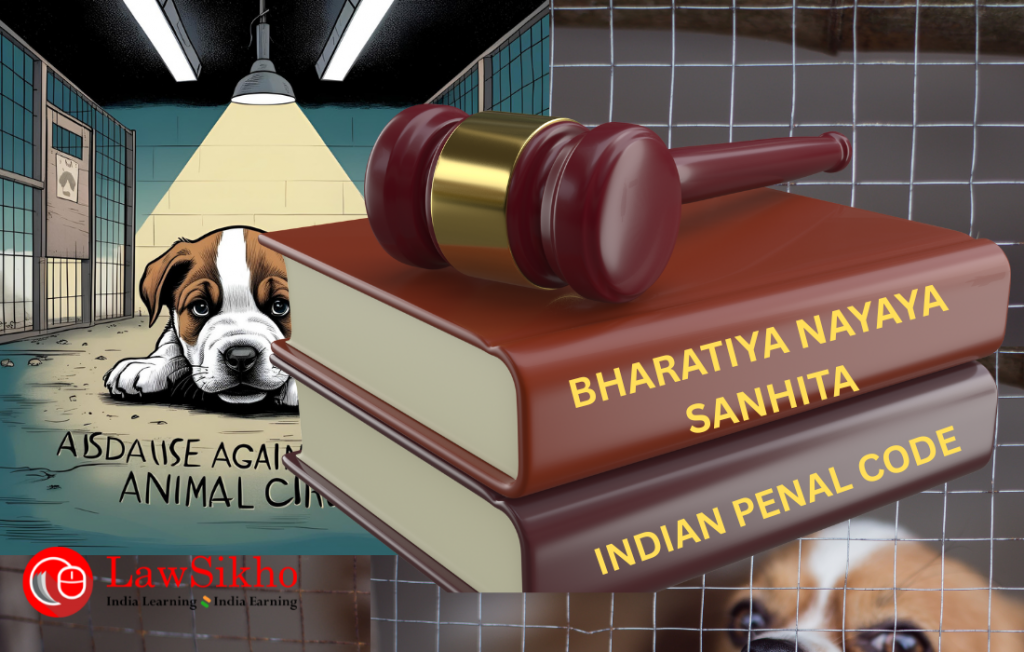In this article, you will learn about the essential changes in the law governing animal cruelty, focusing on the provisions of Bharatiya Nyaya Sanhita (BNS), 2023, which replaced the Indian Penal Code (IPC), 1860. This article is a must-read for all activists, rescuers, community animal caregivers, and lawyers seeking insights to combat animal cruelty under the new legal framework.
Table of Contents
Introduction
Are you an animal lover like me?
Then grab a cup of tea or coffee, because today I have a story close to my heart to share.
This is not about some scandal or a high-profile case.
This story is about Brownie, a skinny indie dog with warm, chocolatey fur and eyes sparkling with hope.
I spotted Brownie living at the edge of my building.
Brownie did not belong to any fancy breed with a shiny collar. He was just a curious dog wagging his tail for every passerby, craving love more than food.
But that sad part is: No one fed him. Instead, people in the society shooed him away and threw stones when he got too close. Kids would throw water on him, and passersby would kick him like a football. I always did my bit to stop them from hurting Brownie.
I did believe that they would stop hurting Brownie at some point. But what happened on that Sunday morning still gives me goosebumps.
As part of my daily routine, I went out to feed him early in the morning. When I reached the usual spot, I could hear him scream in pain, so I went closer. It seemed like someone had poisoned his food.
My heart sank at the moment, but I gathered myself and ran around asking for help. But no one cared enough.
That’s when one old man sighed, “People here think dogs are just strays and not worth the attention”. He told me to leave him there and get back to my work.
But I could not. I rushed him to a vet.
He survived, miraculously. That day, something within me changed.
Why do street dogs face so much cruelty when they ask for so little?
Do they really deserve this? Is it only human life that matters?
I wanted to do something for Brownie and for many others like him.
I wondered what we can do to protect animals?
Well, at that moment, it struck me that the criminal law got a makeover. The good old Indian Penal Code, 1860, was replaced by Bharatiya Nyaya Sanhita, 2023.
So the question was whether this new law gives dogs like Brownie a chance to fight?
Let us dive in to know more about it.
First, let us learn about animal cruelty.
What is animal cruelty?
The term “animal cruelty” is very commonly used. It is a broad term used to describe criminal offences committed against animals that range in severity, type, and scale, such as beating and poisoning animals.
Day in and day out, we hear and also witness cases of dogs being beaten, poisoned, or abandoned. These cases warrant a robust legal framework.
There are several different acts and rules enacted for the protection of animals in our country. Let us see what the laws protecting animals are.
What are the laws governing animal protection?
Animal protection and welfare are governed by a combination of constitutional provisions, central and state laws, and rules.
I will provide a brief overview of the key laws enacted to protect animals.
1. Bharatiya Nyaya Sanhita, 2023
This Act has replaced the Indian Penal Code, 1860 with updated provisions for animal cruelty that we will discuss in detail later in this blog.
2. Prevention of Cruelty to Animals Act (PCA) 1960
It is the primary legislation aimed at preventing cruelty against animals, which was enforced by the Animal Welfare Board of India(AWBI). Section 11 of the Act enlists acts of cruelty. , such as beating, overloading, mutilating, organising animal fights, or improper transportation.
3. The Wildlife Protection Act, 1972
This Act aims to protect and conserve wildlife and their habitats by prohibiting hunting and regulating trade in endangered species.
4. Breeding of and Experiments on Animals (Control and Supervision) Rules 1998
These rules set the ethical standards for breeding and using animals in research.
5. The Animal Birth Control (Dogs) Rules 2023
These rules amended the 2001 rules and provide the guidelines for managing the stray dog population through sterilisation and vaccination.
6. Constitutional provisions
- Article 51(A)(g) – It imposes a fundamental duty on the citizens to protect wildlife and have compassion for living creatures.
- Article 48 and 48A – It directs the state to protect agriculture, animal husbandry and the environment, indirectly supporting animal welfare.
7. State and concurrent lists
- State List (Item 15) – Grants States the authority to prevent animal diseases and enforce veterinary practices.
- Concurrent List (Items 17, 17B) – Covers prevention of cruelty to animals and protection of wild animals and birds.
What are the key provisions under Bharatiya Nyaya Sanhita, 2023, governing offences against animal cruelty?
You are all aware that India has a rich tradition of compassion towards animals, as also reflected in ancient texts and scriptures, and now in modern laws.
The BNS has introduced significant improvements to address animal cruelty.
Let us talk about what has changed. We will first look at the key provisions and compare them to the old provisions in IPC through a table, and then understand them in detail.
| Offense | IPC Section | BNS Section | Punishment |
| Killing/maiming animal | 428, 429 | 325 | Up to 5 years, fine, or both |
| Attempt to commit offense | 511 | 62 | Up to half of primary offense punishment (e.g., 2.5 years for Section 325) |
Let us study these provisions in detail now.
- Section 325 – Mischief by killing or maiming animal
The offence of killing or maiming any animal is now punishable under section 325 of the BNS Act.
Before BNS came into force, animal cruelty was largely governed by
- Section 428 of Indian Penal Code,1860 – Mischief by killing or maiming animal of value of ten rupees
Under this provision, any person who harms any animal worth rupees 10 by killing it, poisoning it, injuring it badly, or making it useless, rendering it incapable of doing anything, shall be punishable with imprisonment for a term up to two years, or fine, or both
- Section 429 of Indian Penal Code, 1860 – Mischief by killing or maiming cattle, etc of any value or any animal of the value of fifty rupees
Under this provision, any person who harms, kills, or injures any animal such as elephant, camel, horse, mule, buffalo, bull, cow or ox, worth rupees 50 or more, rendering the animal, incapable of doing anything shall be punished with imprisonment for a term upto five years or fine or both.
Unlike the sections of IPC, which differentiated penalties based on the value of animals or type of species, there is no requirement of animal value to invoke the offence. It mainly covers all animals, not just cattle or valuable creatures.
So, if someone poisons a stray dog like Brownie, they can be prosecuted under section 325, regardless of the dog’s “value.”
Section 325 consolidated the provisions of sections 428 and 429 of the Indian Penal Code, 1860.
Let us now understand section 325.
Before that, let us see what maiming means.
It means to hurt someone badly, typically resulting in permanent damage or inability to use a body part.
Coming to what this provision means: If any person harms any animal by killing it, poisoning it, maimimg or rendering useles any animal from doing anything, then the person who commits such an act shall be punishable with imprisonment for a term up to five years or a fine or both.
But the BNS missed a trick here. Do you know what?
Well, it does not cover all types of cruelty as is mentioned in section 11 of PCA Act.
Moreover, it could have varied the punishment based on the species involved, whether domestic or endangered, because imprisonment up to 5 years is just a general ballpark.
Plus, imprisonment is not the solution in all cases, especially when minors are involved. It could have made room for community service or awareness on how animals should be treated.
Are you following?
- Section 62 – Punishment for attempting to commit offences punishable with imprisonment for life or other imprisonment
Section 62 has replaced section 511 of the Indian Penal Code,1860.
This provision applies when any person attempts to commit an offence punishable with imprisonment for life or imprisonment, or acts towards commission of such an offence and where no express provision is made, then such an offence shall be punished with imprisonment of any description as provided for the offence for a terms which extend to one half of imprisonment for life or as the case may be one half of the longest term of imprisonment provided for that offence or with fine as provided for that offence or with both.
Let me explain this with an example: If a person starts beating a dog, clearly with the intention to kill it, but before that person kills the dog, someone stops that person. Now, even though the dog survived, the person clearly attempted to kill the dog; then, in that case, the person can be punished under section 62 read with section 325 of BNS.
Was this easy to understand?
Do you know that the BNS has faced criticisms?
But why? Let’s find out.
What are the criticisms against Bharatiya Nyaya Sanhita, 2023?
With the enactment of BNS, it has taken a huge leap but it is not perfect.
The BNS lacks a crucial provision equivalent to section 377 of the IPC, which criminalised bestiality (sexual intercourse with animals).
In the case of Navtej Singh Johar v. Union of India [AIR 2018 SC 4321], the Supreme Court decriminalised consensual unnatural sex, but retained bestiality and non-consensual acts under Section 377 of IPC.
Shockingly, the BNS omitted section 377 entirely, leaving no provision for sexual abuse of animals. This makes street dogs vulnerable and easy targets for horrific acts.
However, Section 11(1)(a) of PCA Act covers cruelty via torture, and section 325 of BNS may apply to maiming through sexual violence, but the scope is very restricted.
The 2023 Parliamentary Standing Committee recommended a bestiality provision, but it was ignored. We can only hope that the legislature incorporates amendments to BNS to combat animal cruelty.
Let us find out how to report a case and what can be done in case the police officer refuses to register a case of animal cruelty.
How to report a case of animal cruelty?
The procedure for filing a complaint in cases of animal cruelty is governed by the Bharatiya Nagarika Suraksha Sanhita, 2023 (BNSS), replacing the Code of Criminal Procedure,1973.
- Under section 173(1) of BNSS, when information about the commission of a cognisable offence is given, the officer in charge of a police station must register an FIR. There is no requirement that the station be “nearest”, which means that a FIR can be registered at any police station.
If you are wondering what a cognisable offence is, it refers to an offence where police officers have the authority to arrest an individual without a warrant and can initiate an investigation without court permission. For instance, section 325 is a cognisable offence.
- As per section 173(2) of BNSS, the informant is entitled to receive a free copy of the FIR immediately after it is recorded.
- As per section 173(4) of BNSS, if an officer refuses to register an FIR, the informant can write to the Superintendent of Police (SP), who is then obliged to either conduct the investigation themselves or assign it if the offence is cognisable.
Although there is a prevailing issue wherein the police often hesitate to register an FIR for animal cruelty due to lack of training or priority, it is essential for citizens to remain persistent and aware of their rights by keeping a copy of the written complaint, documenting the incident (photos/videos), and contacting animal welfare organisations, which can strengthen the case and push authorities to act.
Let us find out the notable judgments that have protected the rights and welfare of animals in India.
What are the notable judgements on animal protection?
- Animal Welfare Board of India v. A. Nagaraja (2014) [2014] 7 SCC 547]: The Supreme Court banned Jallikattu which is practiced in the State of Tamil Nadu (that involves a series of fights between bulls) as the same amounts to cruelty and violates provisions of PCA Act and Article 51(A)(g) of the Constitution.
- People for Ethical Treatment of Animals (PETA) v Union of India:[2005 SCC OnLine Bom 997] In this case, PETA challenged the certification of films that involved the use of animals, alleging non-compliance with the Performing Animals (Registration) Rules, 2001, framed under the Prevention of Cruelty to Animals Act, 1960. The Bombay High Court addressed the issue of whether the Central Board of Film Certification (CBFC) should ensure compliance with these rules before certifying films for public exhibition.
The Court directed that the CBFC must require filmmakers to obtain a No Objection Certificate (NOC) from the Animal Welfare Board of India (AWBI), certifying that the provisions of the Performing Animals (Registration) Rules, 2001, have been complied with. This directive aimed to harmonize the Certification Rules under the Cinematograph Act, 1952, with the animal welfare regulations, ensuring that animals are not subjected to cruelty during film productions.
- N. R Nair and Ors. v Union of India and Ors.[(2001) 6 SCC 84]: In this landmark case, the Supreme Court upheld a notification issued by the Central Government under Prevention of Cruelty to Animals Act, 1960, which prohibited the training and exhibition of certain wild animals specifically bears, monkeys, tigers, panthers, and lions as performing animals. The petitioners, including circus proprietors, contended that this ban infringed upon their fundamental right to practice any profession or to carry on any occupation, trade, or business under Article 19(1)(g) of the Constitution. However, the Court held that the right to trade is not absolute and can be subjected to reasonable restrictions in the interest of the general public. It emphasized that the use of wild animals for entertainment purposes and subjecting them to unnecessary pain and suffering violates the provisions of the Act.
These judgments demonstrate the commitment of the judiciary to uphold animal welfare and to ensure that animals are treated with the compassion and dignity they deserve.
Conclusion
Cruelty against animals often goes unnoticed because we assume no one cares. But the law does. And now, you saw that under the new BNS framework, brought about significant changes to animal protection, acts of killing or maiming animals are now punishable under section 325, while attempts to harm animals fall under section 62, read with section 325. However, BNS fails to criminalise the sexual abuse of animals, an offence previously punishable under section 377. Activists are encouraged to raise awareness and demand amendments to address these gaps.






 Allow notifications
Allow notifications
